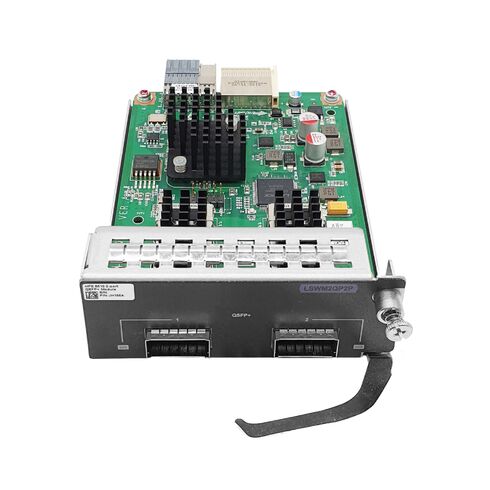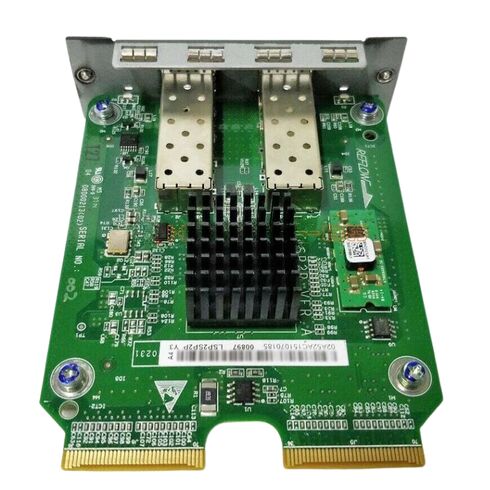JH155A HPE 5510 Qsfp+ 2-port Module
- — Free Ground Shipping
- — Min. 6-month Replacement Warranty
- — Genuine/Authentic Products
- — Easy Return and Exchange
- — Different Payment Methods
- — Best Price
- — We Guarantee Price Matching
- — Tax-Exempt Facilities
- — 24/7 Live Chat, Phone Support
- — Visa, MasterCard, Discover, and Amex
- — JCB, Diners Club, UnionPay
- — PayPal, ACH/Bank Transfer (11% Off)
- — Apple Pay, Amazon Pay, Google Pay
- — Buy Now, Pay Later - Affirm, Afterpay
- — GOV/EDU/Institutions PO's Accepted
- — Invoices
- — Deliver Anywhere
- — Express Delivery in the USA and Worldwide
- — Ship to -APO -FPO
- — For USA - Free Ground Shipping
- — Worldwide - from $30
HPE JH155A 5510 Qsfp+ Expansion Module Overview
Key Features
- Device Type: Expansion Module
- Form Factor: Plug-in Module
Networking Capabilities
Ports & Connectivity
- Ethernet Ports: Dual 40Gb Ethernet Ports
- Technology: Wired Connectivity
- Data Link Protocol: 40 Gigabit LAN
- Data Transfer Speed: 40 Gbps
Expansion and Interface Features
Interfaces for Enhanced Network Expansion
- Interface Type: 2 x 40Gb Ethernet - Qsfp+
Additional Technical Specifications
Form Factor and Device Design
- Module Type: Plug-in Expansion Module
Interface: Qsfp+
What is Qsfp+?
Qsfp+ stands for Quad Small Form-factor Pluggable Plus. It is a compact and hot-pluggable transceiver module used for high-speed communication links. The Qsfp+ interface provides a high-density solution, enabling users to maximize their network performance and efficiency.
Benefits of Qsfp+
1. High Speed
The Qsfp+ interface supports data rates of up to 40 Gigabits per second (Gbps) per port, providing blazing-fast connectivity. This high-speed capability ensures smooth and uninterrupted data transmission, making it ideal for demanding applications and environments where real-time data processing is crucial.
2. Increased Bandwidth
With the ability to transmit data at such high speeds, the Qsfp+ interface offers significantly increased bandwidth compared to traditional interfaces. This means that more data can be transmitted in a shorter amount of time, allowing for improved overall network performance and reduced latency.
3. Versatility
One of the key advantages of the Qsfp+ interface is its versatility. It supports various optical and copper cables, allowing users to choose the most suitable medium based on their specific requirements. This flexibility enables seamless integration into existing network infrastructure without the need for major upgrades or replacements.
4. Space Efficiency
The compact form-factor of the Qsfp+ interface allows for higher port density, enabling users to optimize their network equipment's physical space utilization. By utilizing fewer physical ports while maintaining high-speed connectivity, organizations can save valuable rack space and reduce overall infrastructure costs.
Importance of Qsfp+
1. Future-Proofing
Investing in networking equipment featuring the Qsfp+ interface ensures future-proofing your infrastructure. As data demands continue to grow rapidly, having a high-speed interface like Qsfp+ allows your network to handle increasing bandwidth requirements without the need for constant upgrades or replacements.
2. Enhanced Performance
The Qsfp+ interface's high-speed capabilities enable organizations to handle bandwidth-intensive tasks with ease. Whether it's data-intensive applications, multimedia streaming, or virtualization, the Qsfp+ interface ensures optimized performance, reducing bottlenecks and enhancing overall user experience.
3. Scalability
As businesses grow and expand, their network infrastructure needs to scale accordingly. The Qsfp+ interface provides the scalability required to support future growth without compromising performance. Organizations can add more Qsfp+ enabled modules or switches to their network as needed, ensuring seamless expansion and connectivity.
4. Interoperability
The Qsfp+ interface is widely adopted and supported by various networking equipment manufacturers. This ensures interoperability between different devices, making it easier to integrate new components into existing networks. Users can mix and match compatible Qsfp+ modules from different vendors, providing more flexibility and freedom of choice.
Ports: 2
What are 2 Ports?
The HPE JH155A 2-port Module features two ports that provide connectivity for network devices. These ports act as entry points for data transmission and reception, allowing multiple devices to communicate with each other within a network.
Benefits of 2 Ports
1. Increased Connectivity
With two ports, users can connect multiple devices simultaneously without the need for additional networking equipment. This allows for efficient communication and collaboration between devices, enhancing productivity and streamlining operations.
2. Redundancy and Resilience
Having two ports provides redundancy and resilience in case of a port failure or network congestion. If one port encounters an issue, the other port can continue to handle the network traffic, ensuring uninterrupted connectivity. This redundancy feature enhances network reliability and minimizes downtime.
3. Load Balancing
The presence of two ports enables load balancing, distributing network traffic evenly across both ports. This helps optimize the utilization of available bandwidth and prevents bottlenecks by preventing a single port from becoming overwhelmed with data. Load balancing enhances network performance and ensures efficient data transfer.
4. Flexibility and Segmentation
With two ports, users have the flexibility to segment their network traffic based on their specific requirements. They can dedicate one port for specific tasks or devices, such as connecting to a storage server, while using the other port for general network communication. This segmentation allows for better network management and improved security.
Importance of 2 Ports
1. Scalability
Having two ports provides scalability to accommodate future growth and expansion. As the number of devices in a network increases, additional ports may be required to maintain efficient communication. The 2-port module offers users the ability to easily scale their network by connecting more devices without the need for significant infrastructure changes.
2. Faster Data Transfer
By utilizing two ports, users can distribute network traffic, reducing congestion and improving data transfer speeds. This is especially important in high-demand environments where large volumes of data need to be transmitted quickly, such as data centers or multimedia streaming applications. Faster data transfer improves overall system performance and user experience.
3. Cost-Effectiveness
The inclusion of two ports in a single module eliminates the need for purchasing additional networking equipment or modules. This translates into cost savings for organizations, as they can achieve their connectivity requirements with fewer devices. The 2-port module offers a cost-effective solution for expanding network connectivity without compromising performance.
4. Simplified Network Design
With two ports, network design becomes simpler and more streamlined. Users can connect devices directly to the module without the need for additional switches or routers. This reduces complexity and minimizes points of failure, resulting in a more robust and manageable network infrastructure.
In conclusion, the HPE JH155A 2-port Module with its Qsfp+ interface and two ports provides users with high-speed connectivity, increased bandwidth, scalability, and improved network performance. The Qsfp+ interface's versatility and space efficiency make it an ideal choice for organizations looking to future-proof their infrastructure and enhance their overall network capabilities. The presence of two ports offers increased connectivity, redundancy, load balancing, and flexibility, enabling efficient communication and seamless expansion. Whether it's for data-intensive applications, multimedia streaming, or general networking needs, the HPE JH155A 2-port Module delivers reliable and high-performance networking solutions.











